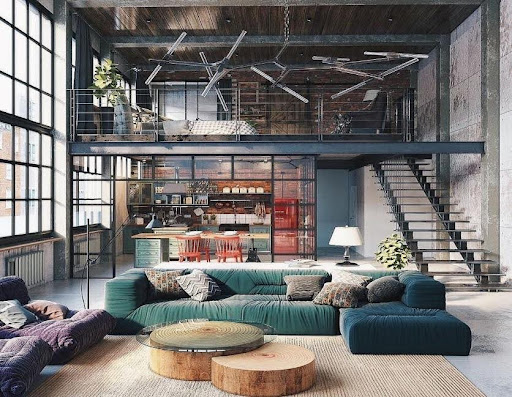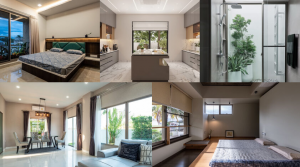The term “loft apartment” evokes images of high ceilings, expansive spaces, industrial aesthetics, and artistic charm. Often spotted in movies and on Pinterest boards, lofts offer a lifestyle that blends modernism with historic character. But what exactly is a loft apartment? Why do they cost what they do? And are they a practical choice for Indian homebuyers or urban renters?
In this blog, we’re diving deep into the world of loft apartments—exploring their features, how to decorate one, their design strengths, limitations, and how they stack up in comparison to studio apartments. Whether you’re a buyer, renter, or design enthusiast, this guide will help you make informed decisions and appreciate the charm of these urban abodes.
What is a Loft Studio Apartment?
A loft studio apartment is an open-plan residential space, usually without internal walls separating areas like the living room, kitchen, or bedroom. While a studio is typically a compact space within an apartment building, a loft generally refers to a larger area, often repurposed from commercial or industrial buildings.
The key defining trait of a loft studio is its open floor plan, high ceilings, large windows, and often, an upper-level platform or mezzanine used for sleeping—known as a loft bedroom.
Why Is It Called a Loft Apartment?
Historically, “loft” referred to an upper story or attic in a building. In the 1960s and ’70s, artists in cities like New York began converting old warehouses and factories into living spaces. These large, industrial spaces offered ample room for creative expression and came with low rent—a winning combo. Over time, this concept gained popularity and turned into the urban-chic living style we now know as the loft apartment.
Is a Loft Different from an Apartment?
Yes, in key ways. A traditional apartment usually has clearly demarcated rooms—bedroom, kitchen, living room—all separated by walls. A loft apartment, on the other hand, emphasizes openness and height. The design prioritizes airiness and flexibility over conventional segmentation.
Features of a Loft Apartment
Let’s take a closer look at what makes loft apartments unique:
Open Floor Plan
The heart of every loft—an open floor plan loft apartment feels expansive, allowing for versatile furniture placement and decor.
High Ceilings
Most lofts come with ceiling heights that range from 12 to 20 feet. This vertical space adds grandeur and allows for lofted sleeping areas or dramatic lighting fixtures.
Large Windows
Expect massive windows, often with black metal frames. They flood the apartment with natural light—making even the most minimalistic designs shine.
Exposed Elements
Pipes, beams, brick walls, or ducts are often left exposed, embracing the raw, industrial charm.
Mezzanine Levels
Most lofts include raised platforms that serve as bedrooms or study areas. However, be mindful of the minimum height for a loft bedroom, which should be around 6.5 to 7 feet for comfortable use.
Loft Apartment Design Tips
Wondering how to decorate a loft apartment without making it look like a warehouse? Here’s your creative guide:
Use Area Rugs to Define Zones
With no walls to separate spaces, rugs can act as invisible borders—demarcating the dining area from the living space or workspace.
Go Vertical
Take advantage of the height by installing tall bookshelves, vertical storage solutions, or statement artwork.
Add Greenery
Introduce indoor plants to soften the industrial look. Tall plants like fiddle leaf figs look stunning in loft corners.
Lighting is Key
Invest in a combination of ambient, task, and accent lighting. Pendant lights or floor lamps can break the monotony of high ceilings.
Smart Furniture
Choose furniture that doubles up on functionality—like a sofa-cum-bed, storage ottomans, or foldable dining sets.
Modern Loft Apartment Floor Plans
Today’s modern loft apartment floor plans are more thoughtfully curated compared to the raw, unstructured layouts of the past. Developers design lofts with:
- Dedicated kitchen zones
- Smart bathroom placements
- Mezzanine bedrooms
- Multipurpose areas for WFH setups
- Walk-in closets or modular wardrobes tucked into corners
These floor plans cater to both aesthetics and utility, making loft living more mainstream.
Pros of Loft Apartments
Why do people gravitate toward lofts? Here’s what makes them desirable:
-
Aesthetic Appeal
Nothing screams modern-chic louder than a tastefully done loft. They’re Instagram-worthy and conversation starters.
-
Spaciousness
The openness can make even a 600 sq. ft. loft feel roomy, especially with high ceilings and natural light.
-
Customizability
You get a blank canvas to create your dream home. Want to set up a gallery wall? A cozy book nook? Go for it.
-
Natural Light
The expansive windows not only reduce the need for artificial lighting but also boost your mood.
-
Perfect for Work-from-Home
With ample space, you can carve out a productive workspace without cramping your living area.
What Are the Disadvantages of Lofts?
While lofts have their charm, they may not be for everyone. Let’s explore the flip side.
Lack of Privacy
If you’re living with someone else, the open layout might compromise on privacy—especially with no doors or walls.
Heating and Cooling Costs
Lofts are harder to heat or cool due to their size and height, which can spike utility bills.
Noise Levels
Sound tends to echo, especially with minimal upholstery and hard flooring.
Maintenance
Dust accumulates quickly on high surfaces, windows, and exposed pipes—making cleaning more laborious.
Staircase Concerns
If there’s a mezzanine level, stairs could be unsafe for kids or elders.
Loft vs. Studio: The Key Differences
While both are open-plan spaces, there are clear distinctions in the Loft vs. Studio debate:
| Feature | Loft | Studio |
|---|---|---|
| Size | Usually larger | Compact |
| Ceilings | High (12–20 ft) | Standard (8–10 ft) |
| Windows | Large and industrial | Moderate |
| Layout | Open, but can include mezzanine | Entire home in one room |
| History | Industrial conversion | Residential from the start |
Are Loft Apartments Expensive?
Short answer—yes, generally. But it depends.
Loft apartments tend to be more expensive than standard apartments due to:
- Prime locations (often city centers or historic buildings)
- Unique architectural features
- Higher utility costs
- Demand among creative professionals and millennials
However, if you’re looking for a loft apartment for sale, keep an eye out for redeveloped mills or warehouses in suburban cities, where prices may be relatively lower.
Loft Apartments in Major Indian Cities: Exploring the Rise of Urban Industrial Living in Mumbai, Bengaluru, Delhi NCR, Pune, and Hyderabad
As metropolitan Indian cities rapidly evolve, loft apartments are emerging as a preferred housing choice for urban professionals, artists, and design-savvy homeowners. This contemporary style of living—once synonymous with reimagined industrial spaces in New York or Chicago—is now finding its unique expression across India’s biggest cities. From SoBo lofts in Mumbai’s converted mills to Bengaluru’s tech-inspired minimalist open layouts, these unconventional homes are redefining urban living. Whether it’s the high ceilings of a South Delhi property, the chic studio-loft combinations in Pune’s IT corridors, or the compact, ultra-modern spaces in Hyderabad’s HITEC City, loft apartments are carving out a distinctive niche in the Indian housing market, blending international design sensibilities with desi practicality.
Comparative Overview of Loft Apartments in Major Indian Cities
| City | Key Loft Apartment Locations | Average Ceiling Height | Popular Loft Styles | Typical Buyer Profile | Market Trend |
|---|---|---|---|---|---|
| Mumbai | Lower Parel, Bandra, Andheri, Worli | 12–14 ft | Industrial-chic, exposed brick, high-end modern | Young professionals, NRIs, creative artists | High demand in luxury & premium segment |
| Bengaluru | Indiranagar, Whitefield, Koramangala | 10–12 ft | Minimalist tech-inspired open plan | Tech professionals, start-up founders, digital nomads | Steady rise in demand |
| Delhi NCR | Hauz Khas, Shahpur Jat, Gurugram, Noida | 11–13 ft | Vintage-industrial with modern fusion | Entrepreneurs, young couples, influencers | Niche but growing interest |
| Pune | Kalyani Nagar, Koregaon Park, Hinjawadi | 10–12 ft | Compact luxury lofts with dual-levels | IT professionals, investors, students | Gaining traction post-2020 |
| Hyderabad | HITEC City, Gachibowli, Jubilee Hills | 9–11 ft | Compact modern-industrial | Techies, creative freelancers, expats | Budget-loft segment emerging |
Conclusion: Should You Opt for a Loft Apartment?
If you crave wide-open spaces, appreciate industrial charm, and value design flexibility, then yes—a loft apartment could be your dream space. But if you prioritize privacy, low maintenance, or budget-friendly living, you may want to explore alternatives.
Regardless of your preference, lofts represent a unique slice of urban real estate—blending history, creativity, and lifestyle in a way few other apartments can.
At Housiey, we simplify your home-buying journey by directly connecting you with trusted builders—no middlemen, no data leaks, no nonsense.
Thinking of getting a wall clock that brings positivity into your new home? Don’t miss our upcoming blog on “Wall Clock Vastu Guide“.






